Enhancing Handwritten Text Recognition with N-Gram Sequencedecomposition and Multitask Learning
Vasiliki Tassopoulou,
George Retsinas,
Petros Maragos

Auto-TLDR; Multi-task Learning for Handwritten Text Recognition
Similar papers
Watch Your Strokes: Improving Handwritten Text Recognition with Deformable Convolutions
Iulian Cojocaru, Silvia Cascianelli, Lorenzo Baraldi, Massimiliano Corsini, Rita Cucchiara

Auto-TLDR; Deformable Convolutional Neural Networks for Handwritten Text Recognition
Abstract Slides Poster Similar
LODENet: A Holistic Approach to Offline Handwritten Chinese and Japanese Text Line Recognition
Huu Tin Hoang, Chun-Jen Peng, Hung Tran, Hung Le, Huy Hoang Nguyen
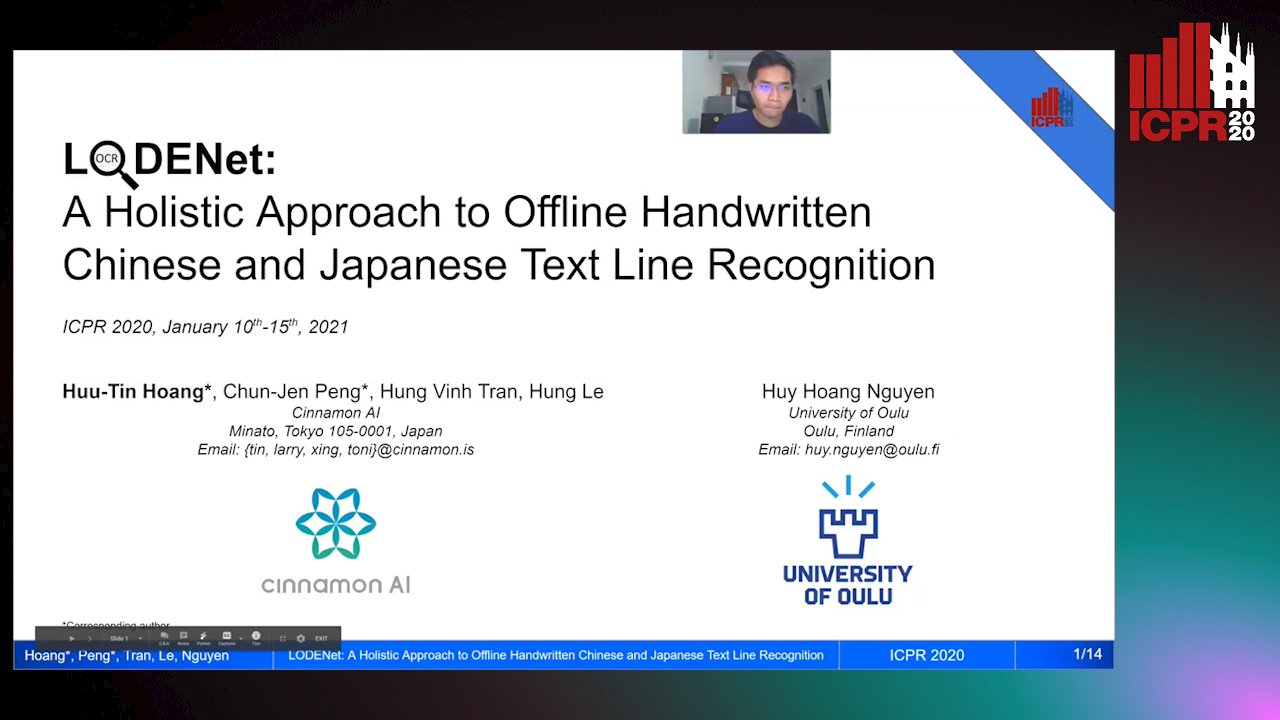
Auto-TLDR; Logographic DEComposition Encoding for Chinese and Japanese Text Line Recognition
Abstract Slides Poster Similar
Cross-Lingual Text Image Recognition Via Multi-Task Sequence to Sequence Learning
Zhuo Chen, Fei Yin, Xu-Yao Zhang, Qing Yang, Cheng-Lin Liu

Auto-TLDR; Cross-Lingual Text Image Recognition with Multi-task Learning
Abstract Slides Poster Similar
Recursive Recognition of Offline Handwritten Mathematical Expressions
Marco Cotogni, Claudio Cusano, Antonino Nocera

Auto-TLDR; Online Handwritten Mathematical Expression Recognition with Recurrent Neural Network
Abstract Slides Poster Similar
ReADS: A Rectified Attentional Double Supervised Network for Scene Text Recognition
Qi Song, Qianyi Jiang, Xiaolin Wei, Nan Li, Rui Zhang

Auto-TLDR; ReADS: Rectified Attentional Double Supervised Network for General Scene Text Recognition
Abstract Slides Poster Similar
Multi-Task Learning Based Traditional Mongolian Words Recognition
Hongxi Wei, Hui Zhang, Jing Zhang, Kexin Liu

Auto-TLDR; Multi-task Learning for Mongolian Words Recognition
Abstract Slides Poster Similar
Improving Word Recognition Using Multiple Hypotheses and Deep Embeddings
Siddhant Bansal, Praveen Krishnan, C. V. Jawahar

Auto-TLDR; EmbedNet: fuse recognition-based and recognition-free approaches for word recognition using learning-based methods
Abstract Slides Poster Similar
Robust Lexicon-Free Confidence Prediction for Text Recognition
Qi Song, Qianyi Jiang, Rui Zhang, Xiaolin Wei

Auto-TLDR; Confidence Measurement for Optical Character Recognition using Single-Input Multi-Output Network
Abstract Slides Poster Similar
Online Trajectory Recovery from Offline Handwritten Japanese Kanji Characters of Multiple Strokes
Hung Tuan Nguyen, Tsubasa Nakamura, Cuong Tuan Nguyen, Masaki Nakagawa
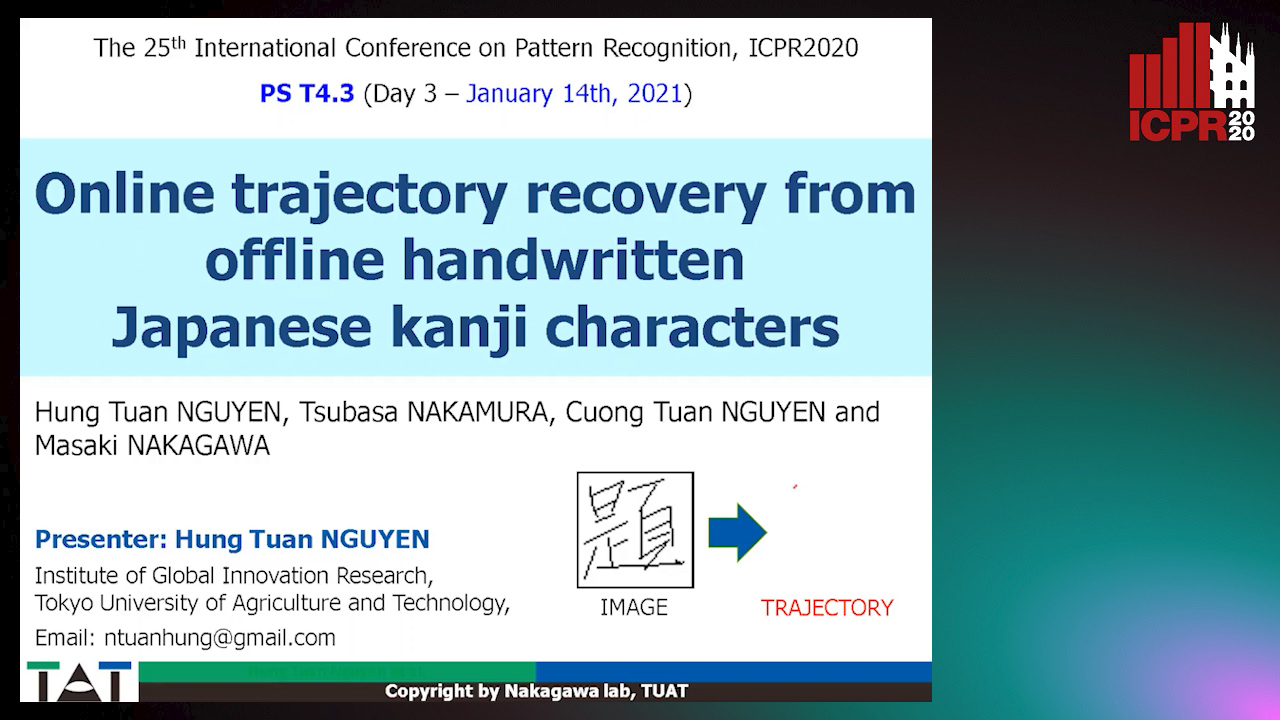
Auto-TLDR; Recovering Dynamic Online Trajectories from Offline Japanese Kanji Character Images for Handwritten Character Recognition
Abstract Slides Poster Similar
The HisClima Database: Historical Weather Logs for Automatic Transcription and Information Extraction
Verónica Romero, Joan Andreu Sánchez

Auto-TLDR; Automatic Handwritten Text Recognition and Information Extraction from Historical Weather Logs
Abstract Slides Poster Similar
ConvMath : A Convolutional Sequence Network for Mathematical Expression Recognition
Zuoyu Yan, Xiaode Zhang, Liangcai Gao, Ke Yuan, Zhi Tang

Auto-TLDR; Convolutional Sequence Modeling for Mathematical Expressions Recognition
Abstract Slides Poster Similar
Context Matters: Self-Attention for Sign Language Recognition
Fares Ben Slimane, Mohamed Bouguessa

Auto-TLDR; Attentional Network for Continuous Sign Language Recognition
Abstract Slides Poster Similar
A Few-Shot Learning Approach for Historical Ciphered Manuscript Recognition
Mohamed Ali Souibgui, Alicia Fornés, Yousri Kessentini, Crina Tudor

Auto-TLDR; Handwritten Ciphers Recognition Using Few-Shot Object Detection
Continuous Sign Language Recognition with Iterative Spatiotemporal Fine-Tuning
Kenessary Koishybay, Medet Mukushev, Anara Sandygulova

Auto-TLDR; A Deep Neural Network for Continuous Sign Language Recognition with Iterative Gloss Recognition
Abstract Slides Poster Similar
Weakly Supervised Attention Rectification for Scene Text Recognition
Chengyu Gu, Shilin Wang, Yiwei Zhu, Zheng Huang, Kai Chen

Auto-TLDR; An auxiliary supervision branch for attention-based scene text recognition
Abstract Slides Poster Similar
Stroke Based Posterior Attention for Online Handwritten Mathematical Expression Recognition
Changjie Wu, Qing Wang, Jianshu Zhang, Jun Du, Jiaming Wang, Jiajia Wu, Jin-Shui Hu

Auto-TLDR; Posterior Attention for Online Handwritten Mathematical Expression Recognition
Abstract Slides Poster Similar
Recognizing Multiple Text Sequences from an Image by Pure End-To-End Learning
Zhenlong Xu, Shuigeng Zhou, Fan Bai, Cheng Zhanzhan, Yi Niu, Shiliang Pu
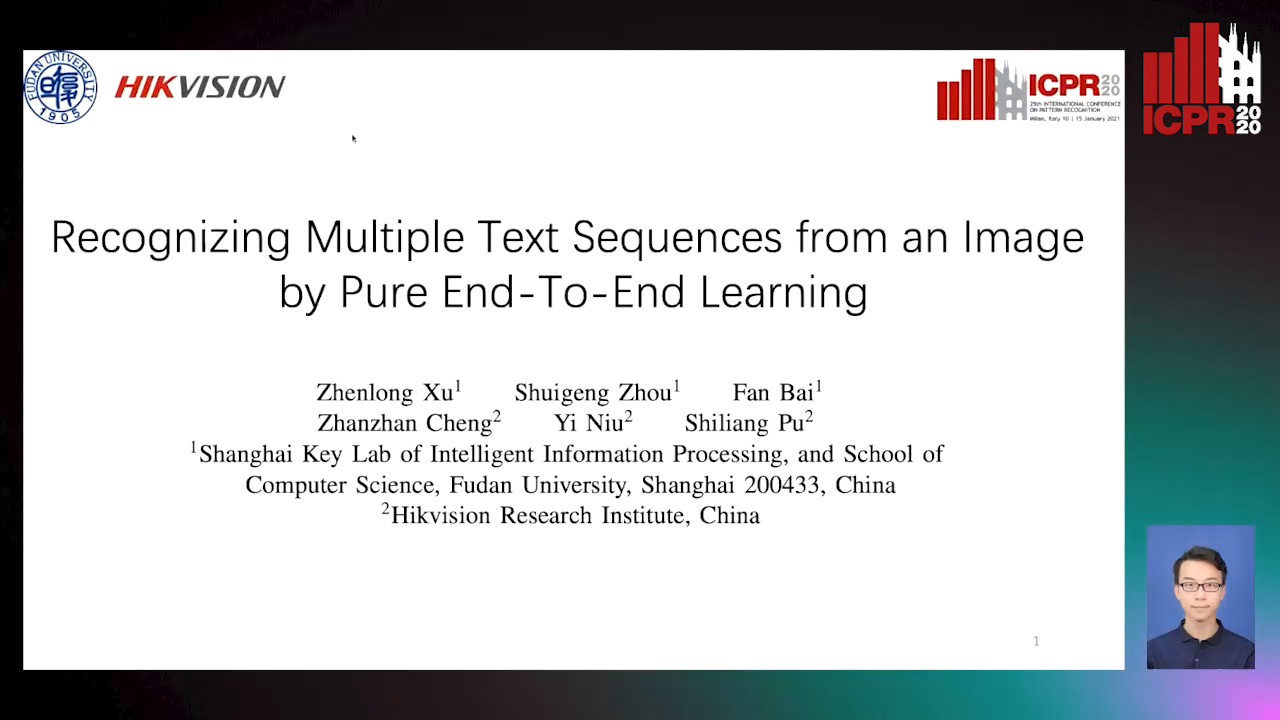
Auto-TLDR; Pure End-to-End Learning for Multiple Text Sequences Recognition from Images
Abstract Slides Poster Similar
Writer Identification Using Deep Neural Networks: Impact of Patch Size and Number of Patches
Akshay Punjabi, José Ramón Prieto Fontcuberta, Enrique Vidal

Auto-TLDR; Writer Recognition Using Deep Neural Networks for Handwritten Text Images
Abstract Slides Poster Similar
IBN-STR: A Robust Text Recognizer for Irregular Text in Natural Scenes
Xiaoqian Li, Jie Liu, Shuwu Zhang

Auto-TLDR; IBN-STR: A Robust Text Recognition System Based on Data and Feature Representation
Global Context-Based Network with Transformer for Image2latex
Nuo Pang, Chun Yang, Xiaobin Zhu, Jixuan Li, Xu-Cheng Yin

Auto-TLDR; Image2latex with Global Context block and Transformer
Abstract Slides Poster Similar
Radical Counter Network for Robust Chinese Character Recognition
Yunqing Li, Yixing Zhu, Jun Du, Changjie Wu, Jianshu Zhang
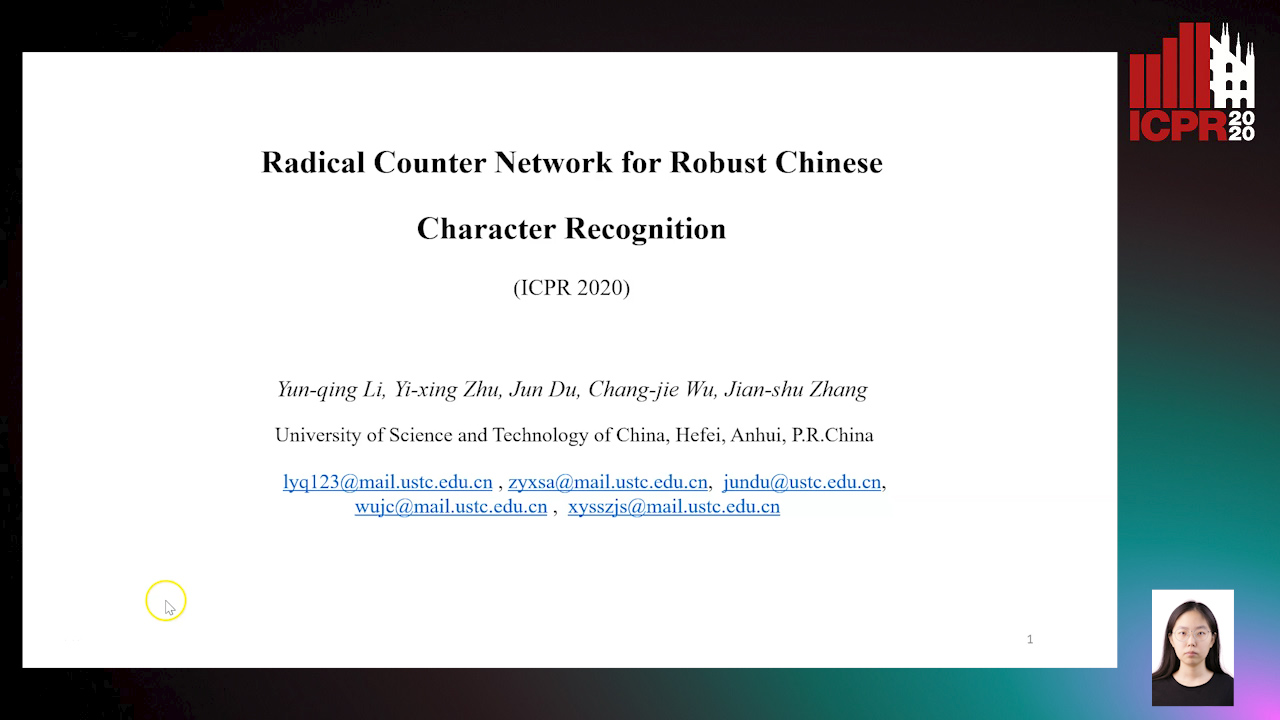
Auto-TLDR; Radical Counter Network for Chinese Character Recognition
Abstract Slides Poster Similar
Stratified Multi-Task Learning for Robust Spotting of Scene Texts
Kinjal Dasgupta, Sudip Das, Ujjwal Bhattacharya

Auto-TLDR; Feature Representation Block for Multi-task Learning of Scene Text
PICK: Processing Key Information Extraction from Documents Using Improved Graph Learning-Convolutional Networks
Wenwen Yu, Ning Lu, Xianbiao Qi, Ping Gong, Rong Xiao

Auto-TLDR; PICK: A Graph Learning Framework for Key Information Extraction from Documents
Abstract Slides Poster Similar
PIN: A Novel Parallel Interactive Network for Spoken Language Understanding
Peilin Zhou, Zhiqi Huang, Fenglin Liu, Yuexian Zou

Auto-TLDR; Parallel Interactive Network for Spoken Language Understanding
Abstract Slides Poster Similar
A Transformer-Based Radical Analysis Network for Chinese Character Recognition
Chen Yang, Qing Wang, Jun Du, Jianshu Zhang, Changjie Wu, Jiaming Wang
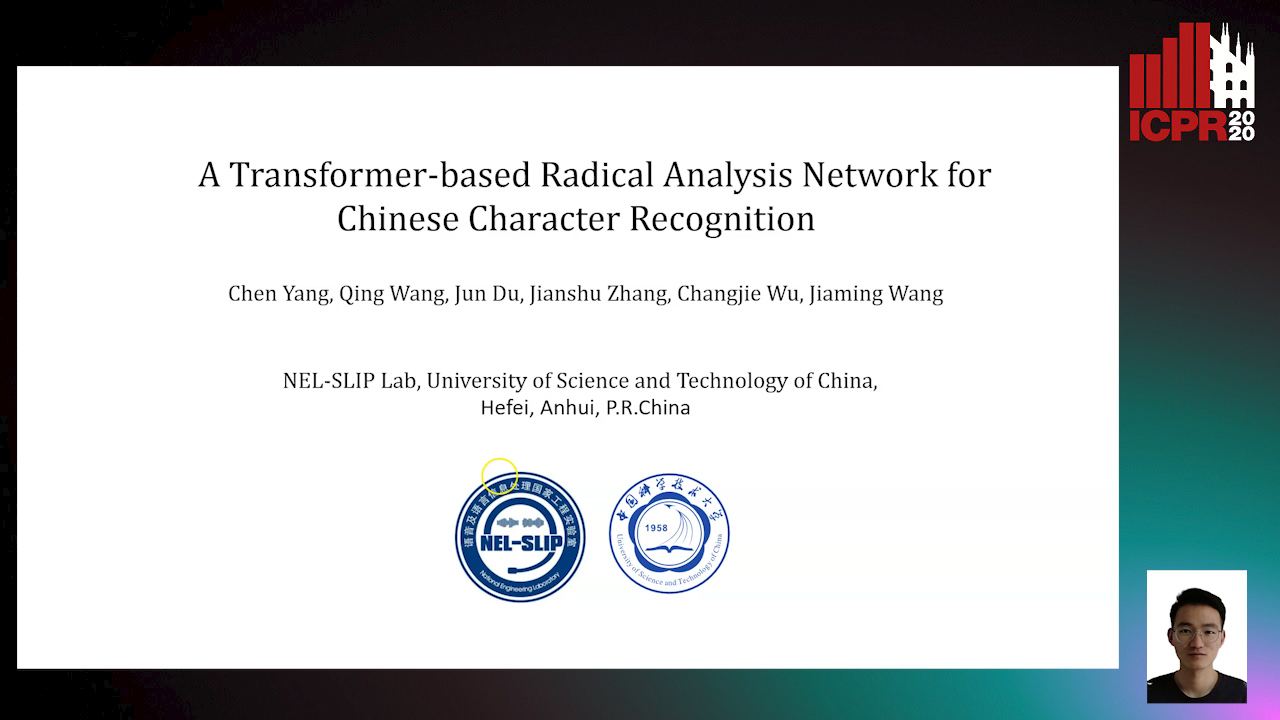
Auto-TLDR; Transformer-based Radical Analysis Network for Chinese Character Recognition
Abstract Slides Poster Similar
Segmenting Messy Text: Detecting Boundaries in Text Derived from Historical Newspaper Images

Auto-TLDR; Text Segmentation of Marriage Announcements Using Deep Learning-based Models
Abstract Slides Poster Similar
A Fast and Accurate Object Detector for Handwritten Digit String Recognition
Jun Guo, Wenjing Wei, Yifeng Ma, Cong Peng

Auto-TLDR; ChipNet: An anchor-free object detector for handwritten digit string recognition
Abstract Slides Poster Similar
2D License Plate Recognition based on Automatic Perspective Rectification
Hui Xu, Zhao-Hong Guo, Da-Han Wang, Xiang-Dong Zhou, Yu Shi

Auto-TLDR; Perspective Rectification Network for License Plate Recognition
Abstract Slides Poster Similar
Predicting Chemical Properties Using Self-Attention Multi-Task Learning Based on SMILES Representation

Auto-TLDR; Self-attention based Transformer-Variant Model for Chemical Compound Properties Prediction
Abstract Slides Poster Similar
Textual-Content Based Classification of Bundles of Untranscribed of Manuscript Images
José Ramón Prieto Fontcuberta, Enrique Vidal, Vicente Bosch, Carlos Alonso, Carmen Orcero, Lourdes Márquez

Auto-TLDR; Probabilistic Indexing for Text-based Classification of Manuscripts
Abstract Slides Poster Similar
Extracting Action Hierarchies from Action Labels and their Use in Deep Action Recognition
Konstadinos Bacharidis, Antonis Argyros

Auto-TLDR; Exploiting the Information Content of Language Label Associations for Human Action Recognition
Abstract Slides Poster Similar
Exploiting the Logits: Joint Sign Language Recognition and Spell-Correction
Christina Runkel, Stefan Dorenkamp, Hartmut Bauermeister, Michael Möller

Auto-TLDR; A Convolutional Neural Network for Spell-correction in Sign Language Videos
Abstract Slides Poster Similar
Handwritten Digit String Recognition Using Deep Autoencoder Based Segmentation and ResNet Based Recognition Approach
Anuran Chakraborty, Rajonya De, Samir Malakar, Friedhelm Schwenker, Ram Sarkar

Auto-TLDR; Handwritten Digit Strings Recognition Using Residual Network and Deep Autoencoder Based Segmentation
Abstract Slides Poster Similar
Multimodal Side-Tuning for Document Classification
Stefano Zingaro, Giuseppe Lisanti, Maurizio Gabbrielli

Auto-TLDR; Side-tuning for Multimodal Document Classification
Abstract Slides Poster Similar
Fast Approximate Modelling of the Next Combination Result for Stopping the Text Recognition in a Video
Konstantin Bulatov, Nadezhda Fedotova, Vladimir V. Arlazarov
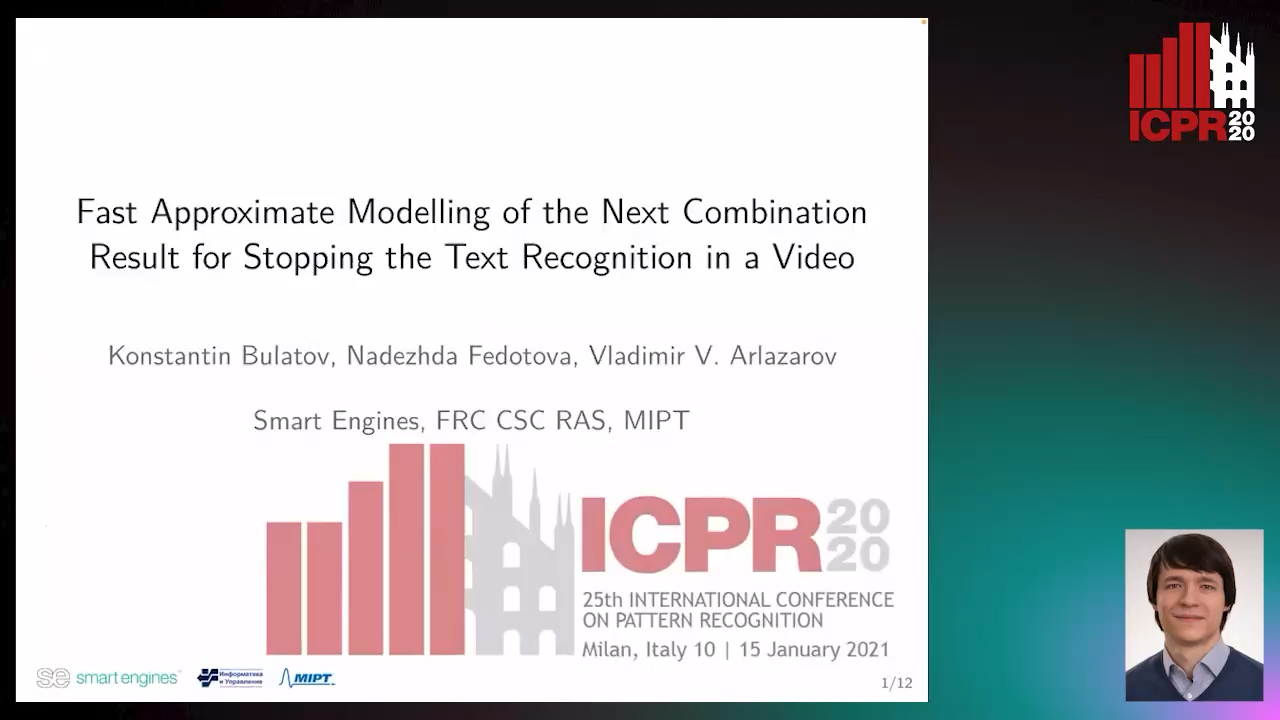
Auto-TLDR; Stopping Video Stream Recognition of a Text Field Using Optimized Computation Scheme
Abstract Slides Poster Similar
Text Recognition - Real World Data and Where to Find Them
Klára Janoušková, Lluis Gomez, Dimosthenis Karatzas, Jiri Matas

Auto-TLDR; Exploiting Weakly Annotated Images for Text Extraction
Abstract Slides Poster Similar
Gaussian Constrained Attention Network for Scene Text Recognition
Zhi Qiao, Xugong Qin, Yu Zhou, Fei Yang, Weiping Wang
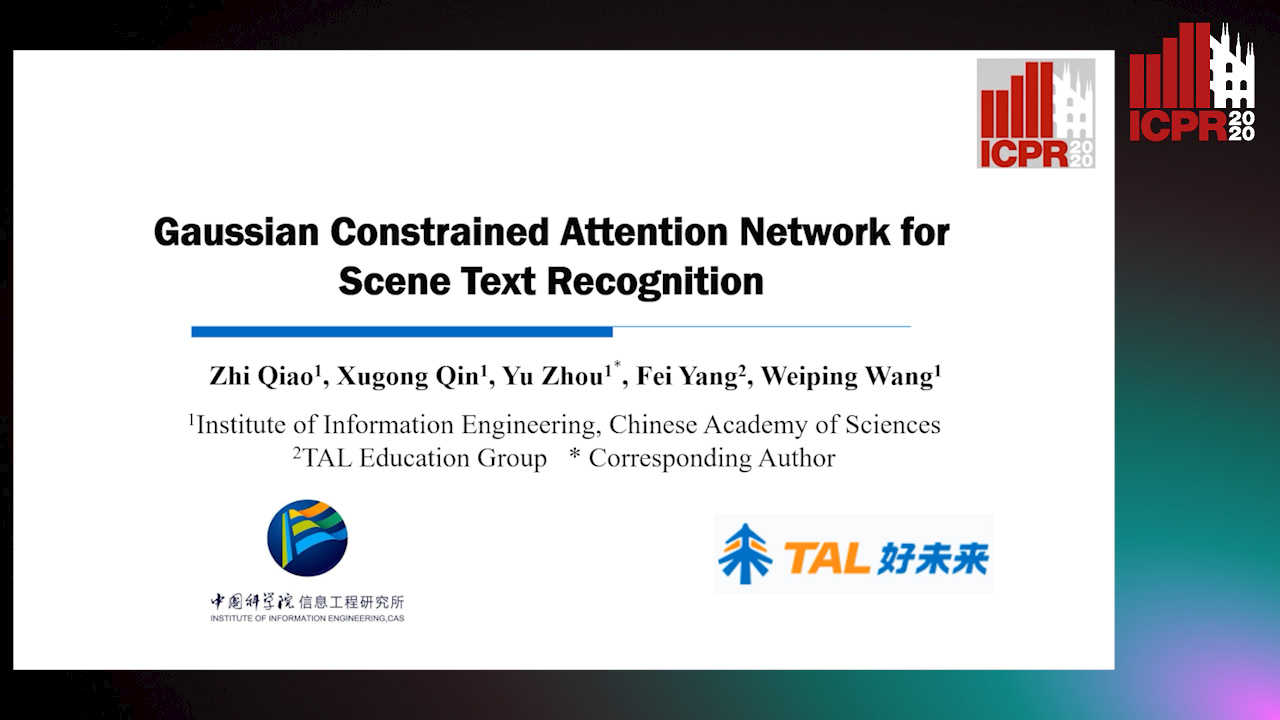
Auto-TLDR; Gaussian Constrained Attention Network for Scene Text Recognition
Abstract Slides Poster Similar
Text Synopsis Generation for Egocentric Videos
Aidean Sharghi, Niels Lobo, Mubarak Shah

Auto-TLDR; Egocentric Video Summarization Using Multi-task Learning for End-to-End Learning
Enriching Video Captions with Contextual Text
Philipp Rimle, Pelin Dogan, Markus Gross

Auto-TLDR; Contextualized Video Captioning Using Contextual Text
Abstract Slides Poster Similar
MA-LSTM: A Multi-Attention Based LSTM for Complex Pattern Extraction
Jingjie Guo, Kelang Tian, Kejiang Ye, Cheng-Zhong Xu
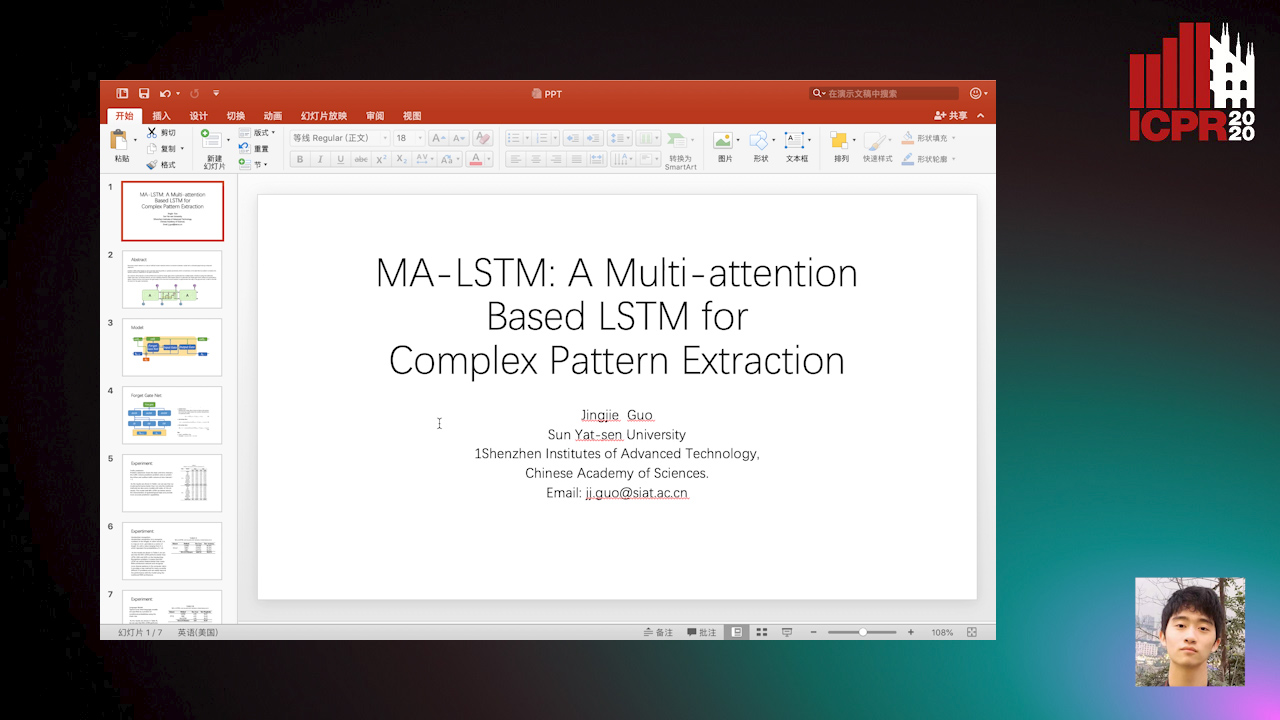
Auto-TLDR; MA-LSTM: Multiple Attention based recurrent neural network for forget gate
Abstract Slides Poster Similar
Cross-People Mobile-Phone Based Airwriting Character Recognition
Yunzhe Li, Hui Zheng, He Zhu, Haojun Ai, Xiaowei Dong

Auto-TLDR; Cross-People Airwriting Recognition via Motion Sensor Signal via Deep Neural Network
Abstract Slides Poster Similar
Recognizing Bengali Word Images - A Zero-Shot Learning Perspective
Sukalpa Chanda, Daniël Arjen Willem Haitink, Prashant Kumar Prasad, Jochem Baas, Umapada Pal, Lambert Schomaker

Auto-TLDR; Zero-Shot Learning for Word Recognition in Bengali Script
Abstract Slides Poster Similar
Text Recognition in Real Scenarios with a Few Labeled Samples
Jinghuang Lin, Cheng Zhanzhan, Fan Bai, Yi Niu, Shiliang Pu, Shuigeng Zhou

Auto-TLDR; Few-shot Adversarial Sequence Domain Adaptation for Scene Text Recognition
Abstract Slides Poster Similar
Revisiting Sequence-To-Sequence Video Object Segmentation with Multi-Task Loss and Skip-Memory
Fatemeh Azimi, Benjamin Bischke, Sebastian Palacio, Federico Raue, Jörn Hees, Andreas Dengel

Auto-TLDR; Sequence-to-Sequence Learning for Video Object Segmentation
Abstract Slides Poster Similar
Audio-Visual Speech Recognition Using a Two-Step Feature Fusion Strategy

Auto-TLDR; A Two-Step Feature Fusion Network for Speech Recognition
Abstract Slides Poster Similar
Trainable Spectrally Initializable Matrix Transformations in Convolutional Neural Networks
Michele Alberti, Angela Botros, Schuetz Narayan, Rolf Ingold, Marcus Liwicki, Mathias Seuret

Auto-TLDR; Trainable and Spectrally Initializable Matrix Transformations for Neural Networks
Abstract Slides Poster Similar
Exploring Spatial-Temporal Representations for fNIRS-based Intimacy Detection via an Attention-enhanced Cascade Convolutional Recurrent Neural Network
Chao Li, Qian Zhang, Ziping Zhao

Auto-TLDR; Intimate Relationship Prediction by Attention-enhanced Cascade Convolutional Recurrent Neural Network Using Functional Near-Infrared Spectroscopy
Abstract Slides Poster Similar
Moto: Enhancing Embedding with Multiple Joint Factors for Chinese Text Classification
Xunzhu Tang, Rujie Zhu, Tiezhu Sun
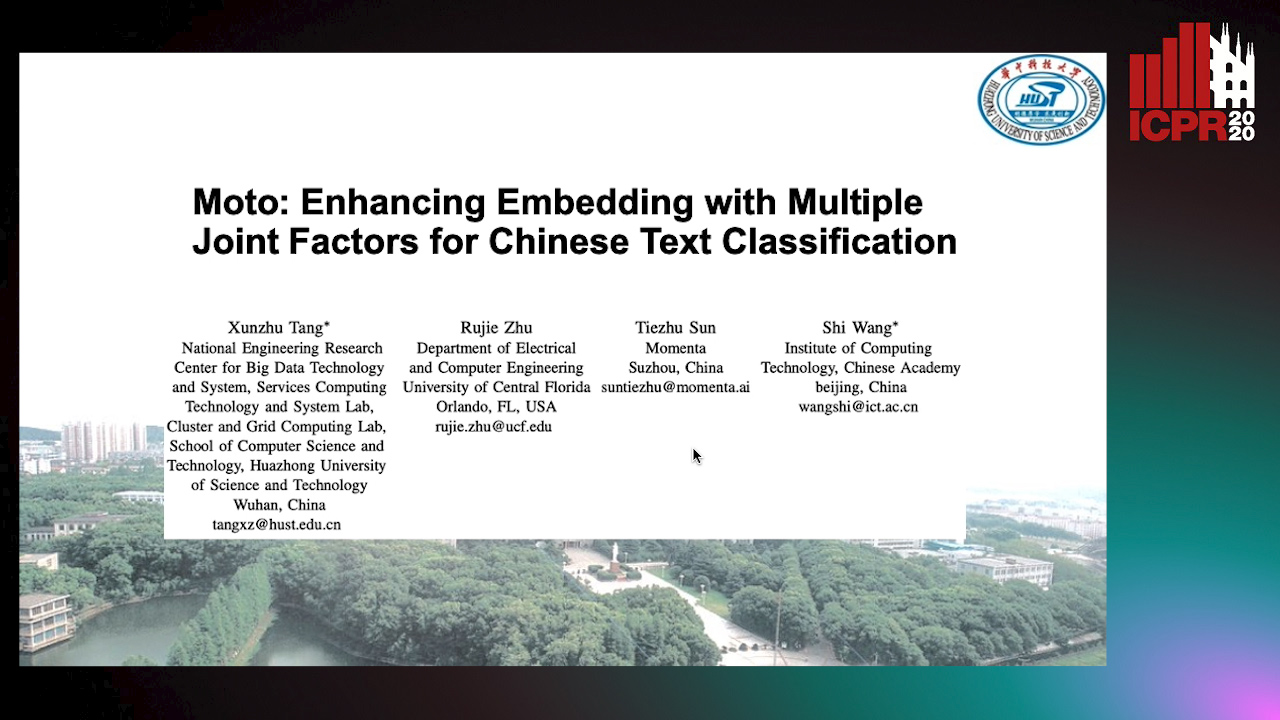
Auto-TLDR; Moto: Enhancing Embedding with Multiple J\textbf{o}int Fac\textBF{to}rs
Abstract Slides Poster Similar